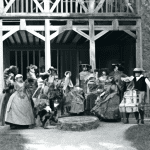Introduction
Castration is a common practice in the farming industry that involves the removal of the testicles in male animals. This procedure is performed for various reasons, including population control, behavior management, and improving the quality of meat. In this article, we will delve into the details of castration in farm animals, its purpose, methods, and potential benefits.
What is Castration?
Castration is the surgical removal or destruction of the testicles in male animals. It is typically performed when the animals are young, before they reach sexual maturity. The procedure can be carried out on various farm animals, including pigs, cattle, sheep, and goats.
Purpose of Castration
1. Population Control: Castration helps control the population of farm animals by preventing unplanned breeding. This is particularly important in situations where overpopulation can lead to resource scarcity and health issues.
2. Behavior Management: Male animals that are not castrated can exhibit aggressive and territorial behavior. Castration helps reduce these aggressive tendencies, making the animals easier to handle and reducing the risk of injuries to both humans and other animals.
3. Meat Quality: Castration can improve the quality of meat produced by farm animals. In some species, intact males may develop a strong, unpleasant odor in their meat, known as “boar taint.” By castrating animals at a young age, the risk of boar taint is significantly reduced, resulting in better-tasting meat.
Methods of Castration
There are different methods of castration, and the choice of method depends on the animal species, age, and available resources. The most common methods include:
1. Surgical Castration: This involves making an incision in the scrotum and removing the testicles. It is typically performed under anesthesia and with proper sterile techniques to minimize the risk of infection.
2. Burdizzo Castration: The Burdizzo method involves using a specialized tool to crush and rupture the blood vessels and spermatic cords, cutting off the blood supply to the testicles. This method is often used in cattle and sheep.
3. Chemical Castration: Chemical castration involves the use of drugs or hormonal injections to suppress the production of testosterone and render the animal sterile. This method is reversible in some cases.
Benefits of Castration
1. Improved Meat Quality: Castrated animals produce meat that is generally more tender and flavorful compared to intact males. This is especially true for species prone to boar taint.
2. Reduced Aggression: Castration helps reduce aggressive behavior in male animals, making them easier to handle and reducing the risk of injuries to both humans and other animals.
3. Population Control: By preventing unplanned breeding, castration helps control the population of farm animals, ensuring resources are efficiently utilized and preventing overcrowding.
Conclusion
Castration is a common practice in the farming industry for various reasons, including population control, behavior management, and improving meat quality. The procedure involves the removal or destruction of the testicles in male animals and can be performed through surgical, Burdizzo, or chemical methods. Castration offers several benefits, including improved meat quality, reduced aggression, and effective population control. By understanding the practice of castration in farm animals, farmers can make informed decisions to optimize their operations and ensure the well-being of their livestock.




